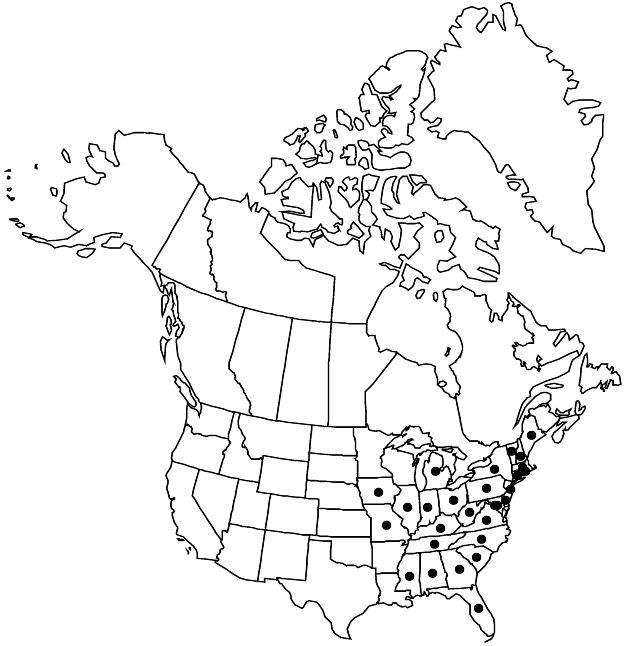Cornus amomum
Gard. Dict. ed. 8, Cornus no. 5. 1768.
Shrubs, to 5 m, flowering at 1.5 m; rhizomes absent. Stems clustered, branches occasionally arching to ground and rooting at nodes; bark green-tan or maroon-tan, not corky, appearing braided, splitting longitudinally; branchlets green abaxially, maroon to green adaxially, turning red-maroon in fall, densely erect-hairy when young; lenticels not protruding on 2d year branches, area surrounding them not suffused with purple on older branches; pith tan or brown. Leaves: petiole 8–25 mm; blade broadly ovate, 8–15 × 4–9 cm, base rounded or truncate, apex abruptly acuminate, abaxial surface yellow-green, hairs brown, tan, or white, both appressed and rigid and others erect and curling on same leaf, tufts of hairs absent in axils of secondary-veins, midvein and secondary-veins densely tomentose, adaxial surface light to dark green, hairs appressed; secondary-veins (4–) 5–6 per side, most arising from proximal 1/2, tertiary-veins perpendicular to secondary-veins, ladderlike. Inflorescences flat-topped or convex, 2–8 cm diam., peduncle 15–80 mm; branches and pedicels green or greenish yellow, turning maroon in fruit. Flowers: hypanthium densely appressed-hairy, especially at base; sepals 1.3–2 mm; petals cream, 3–5 mm. Drupes blue, portion in direct sunlight bleached white, globose, 5–9 mm diam.; stone globose, 4–6 mm diam., irregularly longitudinally ridged, apex pointed. 2n = 22.
Phenology: Flowering May–Aug; fruiting Aug–Oct.
Habitat: Alluvial woods, river and stream banks, wet meadows, marshes, ditches.
Elevation: 0–1500 m.
Distribution

Ala., Conn., Del., D.C., Fla., Ga., Ill., Ind., Iowa, Ky., Maine, Md., Mass., Mich., Miss., Mo., N.H., N.J., N.Y., N.C., Ohio, Pa., R.I., S.C., Tenn., Vt., Va., W.Va.
Discussion
The confusion regarding the name of this taxon dates to the description and plate by L. Plukenet (1691–1705, parts 3, 4) of the “Amomum Nova Angliae quorundum." In his protologue, Miller cited Plukenet and was the first to recognize the ovate-leaved, blue-fruited dogwood of eastern North America. O. A. Farwell (1931) and H. W. Rickett (1934) emphasized the essay by Miller following his description, which indicated red shoots and a whitish undersurface to the leaves; Farwell concluded that Cornus amomum is the correct name for the red-osier dogwood, treated here as C. sericea, whereas Rickett decided that the red shoots and whitish leaf undersurface comments by Miller were a misprint meant instead for C. candidissima, treated here as a synonym of C. racemosa. Because the majority of the description by Miller fits C. amomum better than C. sericea, the interpretation by Rickett is followed here.
Intermediates between Cornus amomum and C. obliqua are common where their ranges overlap; see the latter species for further discussion.
Putative hybrids between Cornus amomum and C. racemosa have been called C. ×arnoldiana Rehder; these have been reported from Massachusetts, Missouri, Ohio, and Pennsylvania.
Selected References
None.